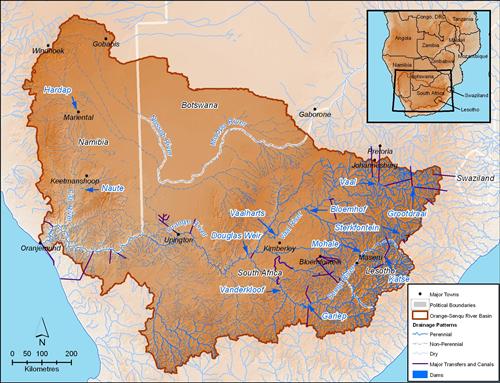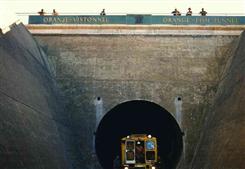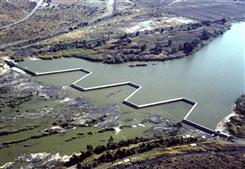Inter-basin transfers, that aim to supplement water-poor basins from more water-abundant basins, are likely to become increasingly important in future. Currently, the major water transfer schemes in the region augment the Vaal River, which supplies Gauteng Province, the industrial and urban centre of South Africa. The most significant of these is the Lesotho Highlands Water Project.
The following table provides a summary of all major transfer schemes in the Orange-Senqu River basin for the Upper Orange, Vaal River and Lower Orange Water Management Areas (WMAs). More detailed information about these schemes can be found on the Department of Water Affairs (DWA) South Africa website. These transfers are also presented in a map below.
Table 1: Major bulk water transfers into and out of the Orange-Senqu River.
|
Orange-Senqu System Sub-basin |
Transfer out of the Orange-Senqu Mm³/a |
Transfer into the Orange-Senqu Mm³/a |
Comments |
|
Upper Vaal |
550 |
780 |
Domestic water to northern Johannesburg and Pretoria with return flows to north west flowing rivers |
|
|
|
790 |
LHWP Phase 1 to Upper Vaal/ Wilge |
|
|
|
63 |
Transfer to the Upper Vaal at Sterkfontein from Thuleka
Transfer to the Upper Vaal above Grootdraai from the Ushutu |
|
Middle Vaal |
none |
|
|
Lower Vaal |
none |
|
|
Upper Orange |
780 |
none |
From the Senqu via LHWP to Upper Vaal/ Wilge |
|
|
575 |
none |
From Gariep Dam via Orange Fish Tunnel to Eastern Cape |
|
Lower Orange |
none |
|
|
Total |
1 905 |
1 633 |
|
UNDP GEF 2008

The major water transfer schemes of the Orange-Senqu River basin.
Source:Hatfield 2009, adapted from UNDP/GEF 2008
( click to enlarge )
Upper Orange Water Management Area
Approximately 60% of the water associated with the Upper Orange Water Management Area, originates from the Senqu River in Lesotho. The two largest storage reservoirs in South Africa (Gariep and Vanderkloof dams), are located in this Water Management Area.
Box:
LHWP – the Largest Water Transferral System in the World
The primary purpose of the Lesotho Highlands Water Project (LHWP) is to satisfy South Africa’s ever-growing thirst, and it is the largest water-transferral project in the world. North of Lesotho lies South Africa’s Gauteng Province, home to the largest industrial complex on the continent. Gauteng’s capital is Johannesburg, one of the few great cities of the world not built close to a major water source.
Today, more than 30% of all South Africans live in and around the city. 50% of the country’s economic output is produced here and 85% of its electricity. Decades ago, the rapidly growing demand for water was already proving too much for the Vaal River, the main tributary of the Orange. As early as in the 1950s plans were drawn up to divert water from the Orange River to the Vaal Dam, the largest reservoir along the Vaal. In effect there were two possible scenarios:
Choice of options
One option – rather expensive – was for South Africa to go it alone by drawing water from the Orange as it flowed through the lowlands south of Lesotho. The downsides of this idea were that the water would be laden with sediment, would require interim storage in reservoirs with high evaporation losses and would need to be pumped hundreds of kilometres to the Vaal Dam, which would involve high costs.
The second option was to cooperate with Lesotho in a solution that was far more economic. This involved drawing crystal-clear water from the Orange-Senqu and its tributaries high in the mountains of Lesotho, temporarily storing it in deep mountain gorges with almost no losses to evaporation, then using gravity to help it flow into a tributary of the Vaal River and thus into the Vaal Dam. Along the way it would have to navigate 45 kilometres of tunnels but there would be no expense on energy.
It was obvious which the better option was. Even though it took 30 years, before Pik Botha, at the time South Africa’s minister of foreign affairs, and Colonel Thaabe Letsie signed the LHWP Treaty on 21 October 1986. According to this treaty South Africa receives an amount of water that steadily increases in five stages. Currently it is paying its neighbour more than 30 million rand a month, representing almost half of the money it is saving. That amounts to nearly a quarter of Lesotho’s export earnings.
Phase1a - creating extremely valuable infrastructure
Phase 1A of the project took place between 1991 and 1997. It embraced the building of the 185 metres high Katse Dam, including an intake tower. This tower is positioned 16 kilometres upstream from the dam wall and is 99 metres high though when the dam is full, 77 metres are under water. Every second 25 000 litres of water – about 800 billion litres per year – flow through the tower’s gates into a tunnel with a diameter of five metres, which transfers the water northwards. This tunnel was built in an extremely challenging terrain and is regarded as a masterpiece of engineering.
During construction, millions of tonnes of material and equipment were freighted into Lesotho’s mountains. Thousands of engineers, technicians and workers were hired, housed and fed. The project established about 120 kilometres of tar road, not to mention bridges, well-equipped villages and 145 kilometres of power lines. All of this turned out to be an extremely valuable infrastructure that opened up remote mountainous areas of Lesotho, financed by South Africa.
The water from Katse Dam makes a detour via the small Muela hydroelectric generating station. This was financed by Lesotho and has an output of 72 megawatts, so it can supply most of Lesotho’s electricity needs. Every second, twelve kilolitres of water from Katse Dam cascade onto the turbine blades, then disappear into a tunnel. From there the water travels underneath the Caledon River and on to Clarence in South Africa where it enters the Ash River, a tributary of the Vaal.
King Letsie III and President Nelson Mandela opened the door to the future
On 22 January 1998, Lesotho’s King Letsie III and President Nelson Mandela of South Africa opened the water transfer system from Katse to the Vaal Dam. A year later Muela began operating. Today, two agencies serve as joint managers of this vast project and its expansion: the Lesotho Highlands Development Authority (LHDA) on Lesotho’s side, and the Trans-Caledon Tunnel Authority (TCTA) in South Africa. Phase 1-B of the project was completed in 2002, this time the 145-metre-high Mohale Dam, which lies southwest of Katse and harnesses a different tributary of the Senqu. Water from Mohale flows through a tunnel into the Katse reservoir and swells its content.
Despite all this, experts predict that by 2013 the Johannesburg area will again begin outstripping its water supply. It is time to implement Phase 2. Early in 2011 politicians signed final contracts giving the go-ahead for a third new dam by 2019, this one rising 165 metres and located in the eastern mountains of Lesotho near Mokothlong. As at Mohale, water will be fed to Katse Dam via a tunnel, which will increase the latter’s transfer capacity by 40 percent. As the different phases kick in, however, the costs per kilolitre of water will inevitably increase.
There’s another consideration. South Africa is not merely short of water but also of energy. Phase 2 also embraces a 1 000-megawatt, pumped storage power plant. This will transfer 80 percent of its electricity to South Africa, marginally reducing the peak load on local coal-fired power plants that emit carbon dioxide and pollute the air. Meanwhile the Lesotho government has identified more than 20 potential sites for additional small hydro power plants, and is inviting foreign investors to help in their construction.
It is clear that the LHWP provides striking benefits for both participants. South Africa receives a growing supply of water and energy at advantageous rates. Lesotho, on the other hand, profits from modern infrastructure, growing revenues and booming employment during the various construction phases.
The Caledon-Modder Transfer Scheme
Bloemfontein is located in the Modder River catchment, which has insufficient water resources to meet its growing requirements. The water supply to Bloemfontein is therefore augmented from the adjacent Caledon River.
-
Welbedacht Dam on the Caledon River was constructed as the main storage element of the Caledon-Modder Transfer Scheme, and water is abstracted from this dam for transfer to Bloemfontein and various smaller users along the way. Water is transferred via the 115 km long Caledon-Bloemfontein pipeline, which has a capacity of approximately 1,2 m/sVarious towns such as Bloemfontein, Botshabelo, Thaba Nchu, Dewetsdorp, Reddersburg and Edenburg are also supplied.
The Novo Transfer Scheme
The Caledon-Modder (Novo) Transfer Scheme transfers water from Knellpoort Dam to Rustfontein Dam in the upper reaches of the Modder River basin to supply growing demand in the Bloemfontein area. This transfer scheme is in fact an extension of the older Caledon-Modder transfer scheme.
The Orange-Fish Transfer Scheme
The Orange-Fish Transfer Scheme transfers water to the Great Fish and Sundays River catchments in the Eastern Cape. Both catchments are water deficient but have fertile soil, which when irrigated is agriculturally productive. This scheme also supplies urban consumers, including Grahamstown and Port Elizabeth.
-
The capacity of the tunnel, with a total length of about 83 km, is 54 m/sWater is transferred from Gariep Dam via the Orange-Fish tunnel to the Fish and Sundays Rivers as well as to Port Elizabeth. A combination of canals, tunnels, balancing dams and natural river courses are used to distribute the water to the irrigators within the Fish-Sundays sub-system, to eventually reach the Port Elizabeth abstraction point at the downstream end.
The Orange-Riet Transfer Scheme
Water is supplied from Vanderkloof Dam to the Riet River catchment via the Orange-Riet Canal. The water is primarily used for irrigation but also supplies the urban requirements of Koffiefontein (including the mine), Ritchie and Jacobsdal.
Orange-Vaal Transfer Scheme
-
Water is abstracted from the Orange River at Marksdrift Weir to be transferred to Douglas Weir in the Vaal River. The water is used mainly for irrigation and to improve the water quality in the Lower Vaal River. The Orange-Vaal Transfer Scheme has a transfer capacity of 6 m/sWater quality is a very important issue in this scheme, as the salinity of water flowing into Douglas Weir has increased in recent years; the transfer scheme was introduced to improve the quality of the irrigation water.
Upper Vaal Water Management Area
The Upper Vaal Water Management Area is the most developed, industrialised and densely populated of all the Orange/Vaal Water Management Areas, and very significant in South Africa from a water resource management perspective. Large quantities of water are transferred into this Water Management Area from the Usutu and Tugela Water Management Areas, as well as the Senqu River in Lesotho. Large quantities of water are released along the Vaal River to support users in the Middle Vaal and Lower Vaal Water Management Areas and are also transferred to the Crocodile West, Marico, and the Upper Olifants catchments to supply large urban/industrial demand centres and Eskom power stations.
Thukela-Vaal Transfer Scheme
Water is transferred from the Upper Tugela Catchment to the Upper Vaal Water Management Area, with a maximum transfer capacity of 19 m³/s.
The purpose of this scheme is:
-
To transfer water from the Tugela River basin to the Vaal River basin.
-
To generate electricity during periods of peak power demand.
Heyshope to Grootdraai Transfer Scheme
Water is transferred from Heyshope Dam in the Upper Usutu Catchment to the Upper Vaal Water Management Area, with a capacity of 10 m³/s, currently limited to 3,8 m³/s.
The Heyshope System consists of the Heyshope Dam and the Geelhoutboom Balancing Dam, with pumps and canals system transferring water from the Heyshope Dam in the Assegaai River to the Upper Vaal Water Management Area, as well as to Morgenstond Dam in the Usutu River basin. The main purpose of the Heyshope Dam is to support the Grootdraai Dam in the Vaal River Basin and also to support the Usutu System in critical periods with transfers to Morgenstond Dam. Grootdraai Dam is mainly used to supply the Sasol Secunda Complex and Eskom power stations in the Upper Olifants Catchment.
The Zaaihoek Transfer Scheme
-
Water is transferred from the Zaaihoek Dam in the Buffalo Catchment to the Upper Vaal Water Management Area, with a maximum transfer capacity of 2,8 m/sWater is supplied to the Majuba power station, government water schemes, and irrigation schemes, and any surplus is transferred to the Vaal River catchment.
The Vaal-Olifants Transfer Scheme
This scheme transfers water from Grootdraai Dam in the Upper Vaal Water Management Area to the Upper Olifants Catchment, with a maximum transfer capacity of 6,5 m³/s.
The Inkomati Transfer system
This system transfers water from Nooitgedacht and Vygeboom dams in the Komati-West Catchment to the Upper Olifants Catchment with a design capacity of 5,8 m³/s.
Vaal River Eastern Sub-system Augmentation Project (VRESAP)
-
This project transfers water from Vaal Dam to the Sasol Secunda complex and the Eskom Power stations in the Upper Olifants Catchment, with a maximum transfer capacity of 5,07 m/s. VRESAP is aimed at stabilising and extending industrial water supply to Sasol Secunda Complex and the Eskom power stations in Upper Olifants.
Middle Vaal Water Management Area
The Middle Vaal Water Management Area is dependant on water releases from the Upper Vaal Water Management Area to supply the bulk of the water required by the urban, mining and industrial sectors. Water is also transferred from the Upper Vaal Water Management Area via the Vaal River through this Water Management Area, to the Lower Vaal Water Management Area.
Lower Vaal Water Management Area
Over 90% of the water used in the Lower Vaal Water Management Area is supplied from releases from the Upper Vaal WMA, and from Bloemhof Dam. About 80% of the water used in this Water Management Area is for irrigation, mainly the Vaalharts irrigation scheme.
 The Orange-Fish transfer tunnel. Source:DWAF South Africa 2009 ( click to enlarge ) |
 Douglas Weir on the lower Vaal River, where water is transfered to support irrigation in the area around Douglas. Source:DWAF South Africa 2009 ( click to enlarge ) |
Lower Orange Water Management Area
As rainfall and runoff are scarce in the west of the Orange-Senqu River basin, surface water resources in the Lower Orange Water Management Area are depend heavily on releases from Gariep and Vanderkloof Dams, with 95% of the water demand being supplied by releases from the Upper Orange Water Management Area. Water requirements in the Lower Orange Water Management Area far exceed its resources. High environmental flow requirements, which include direct evaporation from the Orange River and evapotranspiration from vegetation in and along the river, occur in this Water Management Area. Namibia also abstracts water from the Orange River along the common border area with South Africa.
Table 2: The major inter-basin transfer schemes in South Africa
|
Source Basin
|
RecipientBasin
|
Average Transfer (Mm3/a)
|
Use
|
|
Vaal
|
Crocodile
|
615
|
Industrial, Domestic (Rand Water)
|
|
Vaal
|
Olifants
|
150
|
Industrial (Power Generation
|
|
Olifants
|
Sand
|
30
|
Pietersburg
|
|
Crocodile
|
Limpopo
|
6
|
Gabarone
|
|
Komati
|
Olifants
|
111
|
Industrial (Power Generation
|
|
Usutu
|
Olifants
|
81
|
Industrial (Power Generation)
|
|
Assegaai
|
Vaal
|
81 (150 max)
|
Industrial, Domestic
|
|
Buffalo
|
Vaal
|
50 (90 max)
|
Industrial, Domestic
|
|
Tugela
|
Vaal
|
630
|
Industrial, Domestic
|
|
Tugela
|
Mhlatuze
|
46
|
Industrial, Domestic
|
|
Mooi
|
Mgeni
|
69
|
Industrial, Domestic
|
|
Fish
|
Sundays
|
200
|
Industrial, Domestic
|
|
Orange
|
Buffels
|
10
|
Industrial, Domestic
|
|
Orange
|
Lower Vaal
|
52
|
Industrial, Domestic
|
|
Orange
|
Riet
|
189
|
Irrigation
|
|
Orange
|
Fish
|
643
|
Irrigation, Domestic, Industrial
|
|
Caledon
|
Modder
|
40
|
Industrial, Domestic
|
|
LHWP 1A
|
Vaal
|
574
|
Industrial, Domestic
|
|
LHWP 1B
|
Vaal
|
60
|
Industrial, Domestic
|
|
LHWP 1B
|
Vaal
|
300
|
Industrial, Domestic
|
|
Letaba
|
Sand
|
19
|
Industrial, Domestic
|
|
Riviersonderend
|
Berg
|
100 (130 max)
|
Industrial, Domestic
|
|
Kubusie
|
Buffal/Nahoon
|
120 max
|
Industrial, Domestic
|
|
Sundays
|
Swartkops
|
40
|
Industrial, Domestic
|
